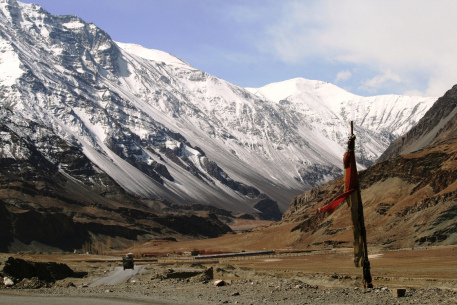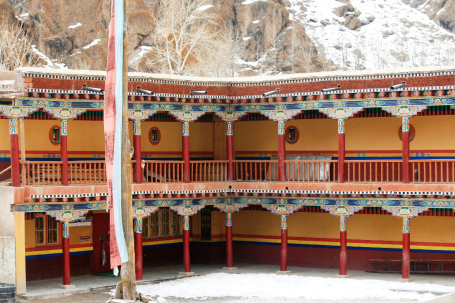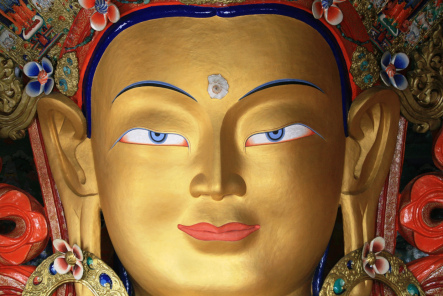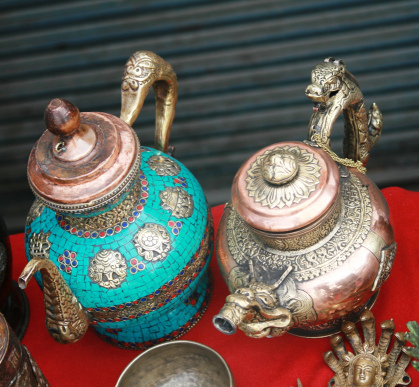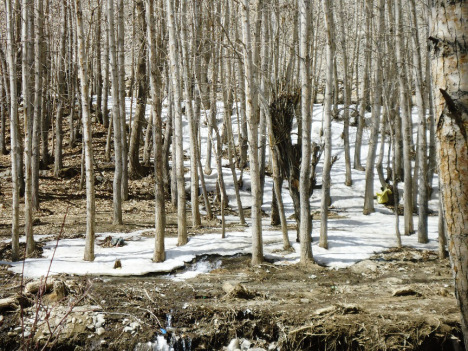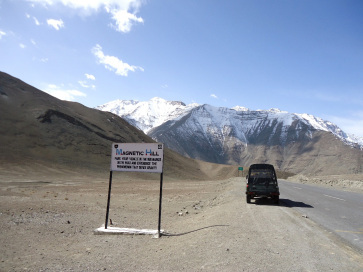Date with serenity
A tryst with spiritualism and peace, Leh is not just a destination but an experience of lifetime
The Mighty Himalayas
A rich experience awaits visitors to Leh, an incredibly beautiful paradise nestled between the snow-peaked Himalayas at an elevation of 3500 m. The delightful sight of prayer flags fluttering in the breeze from the hills, lofty chortens and unpretentious mud houses greet the eyes as one enters the town. Leh was once an important halt on the trade route that connected India, Tibet and China for centuries. This was the route through which pashmina, cannabis, indigo and silk as well as brocade was transported by Bactrian camels on treacherous paths traversing dangerous mountain passes.
The high altitude and extreme weather around the monastery are little encouragement for fauna. During the cold winters, apart from denuded juniper and willow trees, there is hardly any vegetation on the barren land, which has earned it the title of a high-altitude desert. Spring, however, brings a riot of colour in the form of leaves and flowers all around the hills.From an important stopover in the Silk Route to a water-deficit place, Leh has come a long way.
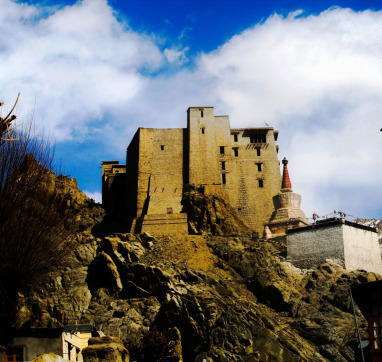 Leh Palace
Leh PalaceThe Leh Palace is a poor cousin of the grandiose Potala Palace that exists at Lhasa. Built in the 17th century by King Singge Namgyal, it was once the residence of the royal family. Today, the nine-storied structure can only boast of a magnificent view of the mountain range across the Indus Valley.
Perched on a hill and now a ruined memory of a glorious past, the sloping walls of the palace were once enveloped by rich murals and grand apartments but now the flaked murals and falling plaster speaks of neglect and vanished splendour. The Palace Museum is a repository of priceless thangkas, crowns, jewellery and other artefacts belonging to the royal family.
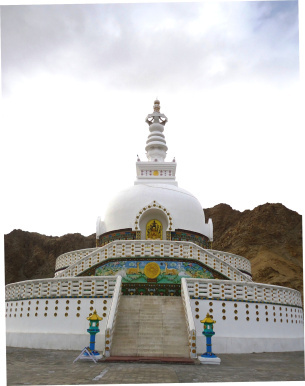 Shanti Stupa
Shanti StupaThe Shanti Stupa, a structure constructed by Japanese Buddhists for world peace, sits atop a hill, looking down upon the city with its surrounding arid lands populated by leafless trees. It offers a spellbinding view of the snow-clad peaks in the distance, a faraway monastery appearing like a speck in the binoculars.
The colourful courtyard of Hemis Monastery
The Hemis Monastery, which lies nearly 45 km away from the town, is a beautiful ancient structure. The ancient Hemis Gompa is one of the oldest and largest monasteries in Ladakh. Well-known for the Hemis Festival with its masked dances that draws thousands of tourists annually, it is otherwise a quiet and secluded monastery. Hemis was once the most prosperous monastery in Ladakh, where people congregated for rituals and benediction regularly. It also has the distinction of housing the largest thangka in the Ladakh region, which is unfolded once in 12 years. The ritualistic Buddhist chanting by the monks, as one perambulates the monastery, adds to the spiritual experience.
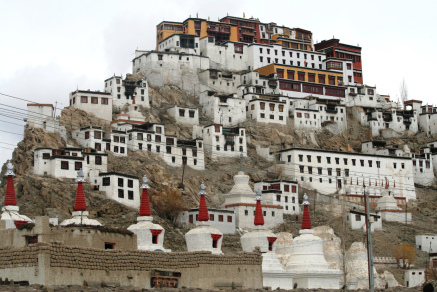 Thiksey Monastery
Thiksey MonasteryFrom there to Thiksey, the picturesque Monastery on hilltop is a beautiful drive away, through soaring poplars and scattered minor monasteries. The monastery turned out to be as beautiful as the pictures had promised. It has a striking resemblance to the Potala Palace and so it is fondly called Little Lhasa.Constructed on the parameters of Ladakhi architecture, the largest monastery in the central Ladakh region, is dedicated to the Gelugpa sect of Tibetan Buddhism (known as yellow hats). The colourful red and white structure, a 12-storied complex with numerous paintings, stupas and shrines cascading down the hill face and is entered through a red gate adorned with colourful mandalas.
Maitreyi Buddha at Thiksey Monastery
The walls of the gallery surrounding the courtyard are covered beautiful murals, including one of kalachakra (the circle of life). The enormous statue of Maitreya Buddha, seated in the lotus pose and wearing an intricately decorated crown, was installed in 1970 to commemorate the Dalai Lama’s visit. Visitors during the prayers hour are greeted by the sight of monks playing on trumpets and gongs while chanting mantras in unison. The adjoining Gonkhangh, reputed to be an ancient one, is a must-visit because the idols are very different to the Maitreya Buddha. The tiny museum within the premises holds a rich collection of thangkas, scriptures and interesting objects like trumpet crafted out of human bone, a wine vessel made from human skull.
exotic artefacts
The old town of Leh is a charming and bustling place with narrow lanes, mud and brick houses and tiny, dilapidated stupas. Most tourists are drawn to the market lining the main street of Leh, which is bounded by an ancient green and white Jama Masjid mosque, at one end and a lofty gateway at the other. The original masjid was constructed in the 17th century following an agreement between the Mughal Emperor Aurangzeb and the Ladakh ruler.The local market is a veritable treasure trove of exotic jewellery, thangkas and shawls that makes the visitors empty their wallets quite willingly. The tiny Tibetan market with its trinkets, prayer wheels, jade Buddha idols, studded incense holders, jewellery boxes, and bric-a-brac is a major tourist attraction.As the sun comes up, dozens of stalls selling vegetables and condiments, nuts and dried fruits, are set up by the roadside.
a frozen rivulet
Ever since the success of the Aamir Khan movie 3 Idiots, the Druk Padma Karpo School, where it was shot has been a star attraction. The school founded by the 12th Gwalwang Drukpa, a spiritual leader of the Ladakh region, has students belonging to impoverished families and boasts of many awards. The nunnery next door is an interesting place to visit. Built on the lines of Ladakhi palaces, this one has a pagoda-type roof, colourful wooden windows and an interesting facade. Known as Naropa Palace, the nunnery is surrounded by a large tract populated by ancient stupas. The prayer hall, with its large images of Buddha and Padmasambhava, is a calming experience where one can meditate for a while.
Out of the town, the Magnetic Hill on the road from Kargil to Leh promises an unusual experience that defies the laws of gravitation. When parked inside the box marked on the road with its engine turned it off and the gear on neutral, the car moves on the slight elevation on its own, at a speed of about 20 kmph. Leh is a place where one can see an incredible sky full of stars and experience a connection with divinity. Replete with white-washed stupas, stunning gompas and warm locals, Leh is not just a destination but an experience of lifetime, a tryst with spiritualism and peace.
FactFile
Reaching there: There are regular flights from Delhi and Mumbai to Leh. One can also do it by road from Manali and Srinagar.
Staying: Leh has dozens of stay options, from the low cost to the costly ones. Hotel Lasermo, Ladakh Residency and The Grand Dragon Ladakh are some of the options.
Other attractions: There are countless monasteries in and around Leh. Alchi, Likir, Shey, Matho, Lamayuru are some of the names. Don’t, however, miss a side-trip to the Pangong Lake and the Nubra Valley.
Food: While there are Chinese, Indian and other cuisines available, the momos, thukpa, pava and skyu are a must-taste. The butter tea is an acquired taste.
Shopping: It is difficult to retain a hold on the wallet when at Leh. The thangkas, carpets, rugs, shawls, prayer wheels, masks and Tibetan jewellery are items to splurge on. Also worth considering are apricots and Himalayan herbs.
(Published in The Sunday Tribune, 31 May, 2015)
Filed under: Travel, Wine and Cuisine Tagged: 3 Idiots, Aamir Khan, chorten, Druk Padma Karpo school, gompas, Hemis Monastery, Jama Masjid, Kalachakra, Leh, Leh Palace, Magnetic Hill, Maitreyi Buddha, Momo, Murals, Pangong Lake, Pashmina, Potala Palace, Shanti Stupa, Skyu, stupas, Thangka, Thiksey Monastery, Thukpa, Tibetan









